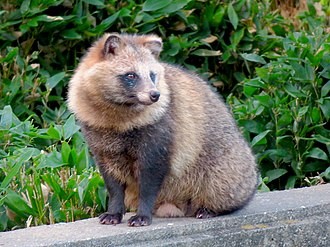The Japanese raccoon dog (also called the Tanuki) is a species that is native to Japan. Mainly nocturnal, although known to be active during daylight. They vocalize by growling or with groans which can sound like domestic cats – they also arch their back (like cats) when trying to intimidate other animals, however it trying to show submissions they behave like other canids by lowering their body to the ground or showing their stomach in submission.

Social groups are usually limited to breeding pairs, but before pairing off, racoon dogs often form groups until this happens.
Usually monogamous, 4-6 pups are born after 9 weeks. They are looked after in the den for a month, and outside the den for a further month. Their wild lifespan is aound 7-8 years with captive specimens having reached 13 years.
They have sharp claws and have been observed usinig these to climb a tree, so as to forage for fruit and berries.
The Japanese raccoon dog is mainly nocturnal, but they are known to be active during daylight. They vocalize by growling or with groans that have pitches resembling those of domesticated cats. Like cats, the Japanese raccoon dog arches its back when it is trying to intimidate other animals; however, they assume a defensive posture similar to that of other canids, lowering their bodies and showing their bellies to submit.
Usually, social groups are limited to a breeding pair, but individual Japanese raccoon dogs may stay in a group of non-paired individuals until they find a mate.[5]
The species is predominantly monogamous. The breeding period for the species is synchronized between females and males and lasts between February and April. A litter (typically with 4–6 pups) is born after a gestation period of 9 weeks. The parents look after their pups at a den for around a month, and then for another month after the pups leave the den.
Japanese raccoon dogs live for 7–8 years in the wild and have reached the age of 13 in captivity.
They have been observed to climb trees to forage for fruits and berries, using their curved claws to climb.
They have been introduced to northern Europe where they are considered to be a pest.











